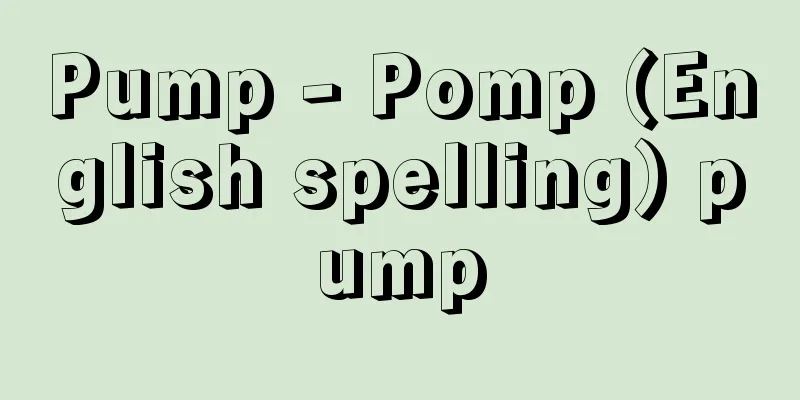Pump - Pomp (English spelling) pump

|
A device that receives mechanical energy from an external source and converts it into fluid energy. In other words, a machine driven by an electric motor or the like that lifts a liquid from a low position to a high position or sends a low-pressure liquid into a high-pressure container. [Shigeru Ikeo] historyWater is essential to human life, and pumps have been used since ancient times. The oldest device for pumping water is the bucket well, which uses a spring bucket, and was used for irrigation in Egypt from around 1550 BC. There are two ways to transport water to high places: putting water in a suitable container and lifting the container itself to the required height, or using a piston or impeller to give the water pressure and speed and lift the water through a pipe. The former is sometimes called a water lifting machine, and the latter a pump. The bucket well mentioned above is a type of water lifting machine. Later, pumps such as wheel wells, chain pumps, and water lifting wheels were invented as water lifting machines, and Joseph's two-stage water lifting wheel, which is said to have been used during the construction of the pyramids, pumped water from 90 meters underground. The screw pump (Archimedes' spiral), said to have been invented by Archimedes in the 3rd century B.C., is a water-lifting machine designed to pump up limescale from the bottom of a ship, and Leonardo da Vinci later left sketches of it. It is still used today as a water-lifting machine in various parts of the world to pump up water in low-lying areas. In addition, the 16th century German Agricola wrote De re Metallica, which describes the use of a three-stage piston pump to drain mines. This pump was powered by a water wheel driven by river water, and was capable of drawing groundwater from a depth of about 60 meters. As civilization developed, there was a demand to lift liquid higher and in larger quantities, but because lifting machines were insufficient, pumps were developed one after another. For example, as industry flourished, more coal was needed as fuel, and coal mines were dug deeper. As you dig deeper into the earth, groundwater naturally comes out, and it is necessary to use a lifting pump to bring it to the surface. As more groundwater comes out as you dig deeper into the mine, pumping machines no longer suffice, and in 1588, the Italian Agostino Ramelli (c. 1530-c. 1590) invented the rotary pump, in 1593, the Frenchman Servier invented the gear pump, and in 1712, the Englishman Newcomen invented the piston pump driven by a steam engine. As the amount of water pumped increased further, piston pumps, gear pumps and other positive displacement pumps were no longer sufficient, and so in 1818, McConty invented the centrifugal pump in America, after which large, high performance pumps were developed one after another, which continues to this day. In Japan, the beginning of the modern pump was the manufacture of the volute pump by Shibaura Engineering Works (now Toshiba) in 1905 (Meiji 38). [Shigeru Ikeo] Pump TypeThe basic performance of a pump is expressed by the total head, which indicates the energy the pump gives to a unit weight of liquid passing through it, the flow rate, which indicates the volume of liquid that can be delivered per unit time, and the rotational speed of the pump. Therefore, there are many types of pumps depending on the total head, flow rate, and type of liquid they handle. Pumps can be classified according to their operating principle into turbo pumps, positive displacement pumps, and special pumps. [Shigeru Ikeo] Turbo PumpA pump is a machine that gives energy to a liquid by the force acting on the blades as the liquid passes continuously through a rotating impeller. Depending on the direction of the flow of the liquid as it passes through the impeller and its relationship to the rotating shaft, pumps are classified as centrifugal pumps, mixed flow pumps, and axial flow pumps. The specific speed or type number is used as an index to determine which pump is most suitable for a given application. The specific speed is a value derived from the hydraulic similarity law of the flow through the pump impeller, and is expressed by the following formula: n s = nQ 1/2 / H 3/4 Since the specific speed is not a dimensionless number and its value changes depending on the units of n , H , and Q , and weight is used to define H , the SI unit system uses mass instead of weight as the base unit, and therefore uses a type number, which is a dimensionless number, instead of the specific speed. The type number K is defined by the following formula, using the effective work E (=g H , g is the acceleration of gravity) done by the pump impeller on a unit mass of liquid instead of the total head H. K = 2π nQ 1/2 /(g H ) 3/4 (1) Centrifugal pumps A pump in which the flow discharged from the impeller is in a plane perpendicular to the axis of rotation, with a volute pump having a volute-shaped casing directly on the discharge side of the impeller, and a diffuser pump having a guide vane-shaped diffuser on the discharge side of the impeller (there may be a volute casing on the outside). Also, according to the suction type of the impeller, centrifugal pumps are divided into single-suction pumps and double-suction pumps. A centrifugal pump with an impeller suction port on only one side is called a single-suction pump, and a centrifugal pump with an impeller suction port on both sides is called a double-suction pump. In general, double-suction pumps are used when a large discharge volume is required. Furthermore, according to the number of stages of the impeller, pumps are divided into single-stage pumps and multi-stage pumps. A single-stage pump is a pump in which the liquid entering the pump passes through one impeller, and a multi-stage pump is a pump in which the liquid entering the pump passes through two or more impellers in sequence. In a multi-stage pump, the liquid receives energy from each impeller, so the total head of the pump can be very high. Therefore, the multi-stage method is sometimes used in other types of pumps. Centrifugal pumps are suitable for pumps with a small discharge volume Q and a large total head H , but pumps within this range are used for a wide variety of purposes, including domestic wells, water supply to buildings, chemical industries, waterworks, industrial water, boiler water supply for thermal and nuclear power plants, fuel supply for space rockets, and hydraulic transportation of coal and fresh fish. Therefore, centrifugal pumps account for about 70% of all pumps produced annually in terms of value and more than 90% in terms of number (according to the 1985 Ministry of International Trade and Industry Factory Statistics). (2) Mixed-flow pumps: A pump in which the flow discharged from the impeller is within a conical surface with the center line of the rotating shaft as its axis, and which generally has a guide vane-shaped diffuser on the discharge side of the impeller. In the past, mixed-flow pumps were not used much because the shape of the impeller is three-dimensional and complex, making it difficult to design a highly efficient mixed-flow impeller. However, in recent years, with the development of computers, it has become possible to design highly efficient impellers using computers, and mixed-flow pumps have been expanding into application fields where axial flow pumps and double-suction centrifugal pumps were previously used. Currently, mixed-flow pumps are used for farm irrigation, water supply and sewage systems, cooling water circulation in thermal and nuclear power plants, dock drainage, etc. (3) Axial flow pump: A pump that pumps water by rotating an impeller similar to a ship's screw propeller, with the direction of water flow at the inlet and outlet of the impeller being the direction of the rotation axis. It is also called a propeller pump due to the shape of the impeller. It is composed of a shaft, impeller, guide vanes, body, and bearings, and when pumping the same amount of water, the outer diameter of the impeller is smaller than that of a centrifugal pump, and since there is no volute part in the casing, the shape is small and the volume is about half that of a centrifugal pump. It is used when the discharge volume is very large and the head is low, and is used for agricultural water pumping or drainage pumps, industrial cooling water circulation pumps, and rainwater drainage pumps for flood control. [Shigeru Ikeo] Positive Displacement PumpThis type of pump is widely used as a hydraulic pump, which puts a certain amount of the flowing liquid into a space with a certain volume, exchanges energy with the liquid, and then discharges it from there. This type of pump is divided into reciprocating and rotary pumps. The former sucks in the liquid from the suction port by a piston moving in and out of a cylinder equipped with a suction valve and discharge valve like a hand pump, stores the liquid in the cylinder, and then sends it out to the discharge port. Single-acting pumps, which have the simplest structure and use only one cylinder, cause pulsation in the amount of water delivered, so double-acting and differential reciprocating pumps are used to average the amount of water delivered. Although reciprocating pumps have a small amount of water delivered, they are the most suitable pumps for high-pressure operation, and many reciprocating pumps with several sets of cylinders and pistons built into the rotor are used for hydraulic purposes. They are also widely used for general water delivery and for high-pressure applications such as oil refining, petrochemical industry, synthetic fiber industry, and synthetic resin industry. The latter type of rotary pump (rotary pump), like a gear pump, traps liquid between the rotor and a fixed wall as the rotor rotates, and moves the liquid from the suction side to the discharge side. Other types of rotary pumps include vane pumps and screw pumps. Compared to reciprocating pumps, they do not require suction and discharge valves, are relatively simple in structure, and generally have little fluctuation in discharge volume. As they have many solid friction parts, they are suitable for pumping lubricating liquids, and as low-flow, high-pressure pumps, they are often used as hydraulic pumps. They are also used to transport water, heavy oil, tar, gasoline, paint, etc. [Shigeru Ikeo] Special Type PumpThere are pumps based on various operating principles, the most representative of which are as follows: (1) Viscosity pump: A pump that rotates a cylinder or disk inside a container and uses the viscosity of the liquid to generate a pumping action through laminar friction. Because energy conversion is performed using friction, losses are inevitable and, in principle, 100% conversion efficiency is impossible. In addition, because the flow rate is small, it is only used for special applications such as lubricating oil pumps. (2) Vortex Pump: Also known as a regenerative pump, friction pump, or Wesco pump. When an impeller with many long, thin radial grooves on both sides of the outer circumference of a disk is rotated inside a casing, a circulating flow is generated in the mixing chamber, and the liquid given peripheral velocity by the impeller moves outward, imparting its momentum to the liquid in the mixing chamber to increase its pressure. The gap between the casing and the impeller needs to be about 0.1 mm. Because energy conversion is carried out through turbulent motion, the efficiency is low at around 30%, but the structure is simple and it is suitable for small flow rate, high head applications, and it is widely used as a domestic well pump. (3) Water Hammer Pump When water is flowing through a pipe and the valve at the outlet end is suddenly closed, the water pressure in the pipe rises instantaneously. This phenomenon is called water hammer, and the shorter the valve is closed, the greater the rising pressure. A pump that uses this instantaneous rising pressure to lift part of the flowing water to a higher place is called a water hammer pump. This pump does not require a prime mover or fuel, has low maintenance costs, and is highly reliable, but it pumps a small amount of water and is somewhat noisy. These characteristics make water hammer pumps suitable for use in developing countries. In Japan, they are often used for dairy farming and simple water supply systems. Another inexpensive pump that is suitable for use in developing countries and has a simple structure and does not require a prime mover is the solar-powered water pump. This pump pumps water by increasing the pressure inside a cylinder during the day due to the generation of steam by solar heat, and by condensing the steam at night due to the low temperature, which reduces the pressure inside the cylinder (generating a vacuum) and draws water up from below. (4) Jet Pump Also called a jet pump. Using the same principle as a spray bottle, it uses a jet of high-energy driving fluid to suck low-energy fluid from a suction pipe, and then gives it energy and sends it to a high-pressure section. The jet pump, which uses high-pressure water as the driving fluid to pump water, was invented in England in 1852 by J. Thomson. As it has no moving mechanical parts, it is suitable for pumping muddy water and sewage, and is used for draining spring water when digging tunnels and tunnels, and for firefighting water in factories. Pumps that use a jet of liquid to send out gas are used as vacuum pumps, pumps that use a jet of steam to raise liquid and supply it to a boiler are called injectors, and pumps used to supply hot water for heating and baths, and to pump limescale from the bottom of ships are called ejectors. (5) Air bubble pump A pump that pumps water by blowing compressed air into the bottom of a pipe inserted underwater, and taking advantage of the fact that the specific gravity of the mixture of air bubbles and water that forms in the lift pipe is less than that of the surrounding water. It was first invented in 1797 by German mining engineer E. Löscher. The more evenly the air bubbles are mixed with the water, the more efficient the pump is, so the problem lies in the structure of the attachment part between the air pipe for sending in the compressed air and the lift pipe. The structure is extremely simple, and since there are no moving mechanical parts in the water, there is no risk of damage and it is easy to repair, but an air compressor is required to send in the air. Since there are no moving parts other than the air compressor, there is no risk of wear or breakdown, but it has the disadvantages of requiring deep wells and low efficiency. It is used for oil extraction and hydraulic transportation of soil and coal in shafts. In recent years, other advantages of this pump have been noted, such as the fact that it oxidizes impurities in wastewater by air cleaning, and that it is more suitable than ordinary pumps for pumping hot water. (6) Electromagnetic pump: A pump that transports liquid metal with high electrical conductivity by electromagnetic force, and is used as an auxiliary pump for liquid sodium-cooled fast breeder reactors. Electromagnetic pumps have the advantages of being able to easily and continuously change the flow rate, being completely sealed with no moving parts, and having no restrictions on where they can be installed, but they have the disadvantages of being low in efficiency (45% or less) and large in size. (7) Vacuum pump A machine that sucks in gas from a container and releases it into the atmosphere, reducing the pressure inside the container to a value close to absolute vacuum. It applies energy to low-pressure gas, compresses it to atmospheric pressure, and releases it; its operating principle is the same as that of a compressor. Vacuum pumps are divided into reciprocating and rotary mechanical vacuum pumps, and jet vacuum pumps that use a jet of gas or steam. Rotary mechanical vacuum pumps include Roots, liquid ring, and oil-sealed types. Diffusion pumps, which combine a jet vacuum pump with a mechanical auxiliary vacuum pump, are used to achieve high vacuums that cannot be achieved by mechanical vacuum pumps. [Shigeru Ikeo] Pump IssuesThe following phenomena must be taken into consideration when designing, manufacturing, and operating a pump. [Shigeru Ikeo] CavitationInside the pump, the flow rate and pressure vary greatly depending on the location. When the flow rate increases at a certain point and the pressure drops to the saturated vapor pressure at that liquid temperature, the liquid boils in that area and vapor bubbles are generated. These vapor bubbles flow downstream and collapse when the pressure reaches a point where it is equal to or higher than the saturated vapor pressure. This is called cavitation. If the pressure drops further, the amount of bubbles increases and they obstruct the flow of the liquid, reducing the efficiency and pump head, generating noise and vibration due to the collapse of the bubbles, and even damaging the surrounding materials. When cavitation develops in a centrifugal pump, the impeller passage becomes clogged with bubbles and the pump is no longer able to pump liquid. In contrast, in mixed flow pumps and axial flow pumps, the impeller passage is wide and is not clogged with bubbles, so the pump's head curve drops overall. Cavitation occurs not only in turbo pumps but also in positive displacement pumps. When cavitation occurs in a hydraulic positive displacement pump, the discharge flow rate decreases, the discharge pressure pulsates, and vibration and noise increase. In addition, the high impact pressure generated when the bubbles disappear causes erosion of the metal surface. [Shigeru Ikeo] Water hammer effectWhen the flow rate in a pipeline changes suddenly due to a sudden stop or start of a pump, loss of pump driving force due to a power outage, valve operation, etc., large pressure fluctuations occur in the pipeline. This phenomenon is called water hammer. This phenomenon is a problem of the pipeline itself and is unrelated to the performance of the pump, but water hammer must be taken into consideration when deciding on the operation and control methods of the pump. [Shigeru Ikeo] SurgingIn a piping system that includes a turbo pump, when the pump is operated in the low flow range, periodic fluctuations in the discharge volume and discharge pressure occur even though no external forcing force is acting, making safe operation impossible. This is called surging. It is a self-excited vibration in the piping system caused by the discharge volume-discharge pressure characteristics of the turbo pump, and occurs when the pump head curve has an upward sloping portion to the right and there is an air chamber or air bubble accumulation in the piping. [Shigeru Ikeo] "Fluid Machinery" by Hideo Ohashi (1987, Morikita Publishing)" ▽ "Pump Engineering" by Kiichi Sato and Masuji Matsumura (1969, Nikkan Kogyo Shimbun)" ▽ "New Edition of Pumps - Their Equipment, Operation and Maintenance" edited by the Japan Society of Mechanical Engineers (1985, Maruzen)" [Reference] | | |©Shogakukan "> Pump Classification ©Shogakukan "> Relationship between impeller cross-sectional shape and specific speed ©Shogakukan "> Selection diagram for turbo pump types (50Hz… Source: Shogakukan Encyclopedia Nipponica About Encyclopedia Nipponica Information | Legend |
|
外部から機械的エネルギーを与えられ、それを流体のエネルギーに変換する装置。すなわち、電動機などによって駆動され、低いところにある液体を高いところに揚液したり、低圧の液体を高圧の容器の中に送り込んだりする機械をいう。 [池尾 茂] 歴史人間の生活にとって水は欠くことのできないものであり、古くからポンプが用いられてきた。水をくみ上げるもっとも古い装置は、はねつるべを使うつるべ井戸で、紀元前1550年ごろからエジプトで灌漑(かんがい)に用いられていた。水を高所に運ぶ方法としては、適当な容器に水を入れその容器自体を必要な高さまで運んで揚水する方法と、ピストンまたは羽根車などを用いて水に圧力と速度を与えて、その水を管を通して揚水する方法とがある。前者を揚水機、後者をポンプと区別してよぶこともある。前述のつるべ井戸は揚水機の一種である。その後、揚水機としては、車井戸、鎖ポンプ、水揚げ車などが考案され、ピラミッド建設工事中に用いられたというヨセフの2段水揚げ車は90メートルの地下から水をくみ上げていた。前3世紀にアルキメデスが考案したといわれるスクリューポンプ(アルキメデスの螺旋(らせん))は船底の水あかをくみ上げるために考案された揚水機で、後にレオナルド・ダ・ビンチもスケッチを残している。これは、現在でも世界各地で水揚げ機として低地の水のくみ上げ用に使用されている。 また、16世紀にドイツのアグリコラが著した『デ・レ・メタリカ』には、鉱山の排水用にすでに3段のピストンポンプを使っていたことが記載されている。これは、川の水で水車を回して動力源としたもので、約60メートルの深さから地下水をくみ上げることができた。 文明の発達に伴い、より高くそしてより多く揚液することが要求され、揚水機では不十分のため、ポンプが次々と開発された。たとえば、工業が盛んになると燃料としての石炭が多く必要になり、炭鉱はより深く掘っていくことになる。地中深く掘っていくと、当然地下水が出てくるため、揚水ポンプで地上にくみ出す必要がある。坑内をより深く掘ると地下水はより多く出るので、揚水機ではまにあわなくなり、1588年にイタリアのラメリAgostino Ramelli(1530ころ―1590ころ)がロータリーポンプを、1593年にフランスのセルビエールが歯車ポンプを、また1712年にイギリスのニューコメンが蒸気機関で駆動するピストンポンプを発明した。 揚水量がさらに増えるとピストンポンプ、歯車ポンプなどの容積型ポンプではまにあわなくなり、1818年にアメリカでマッコンティにより遠心ポンプが開発され、その後、大型・高性能のポンプが次々に開発され今日に至っている。日本では、1905年(明治38)に芝浦製作所(現、東芝)が渦巻ポンプを製造したのが、近代的なポンプの始まりである。 [池尾 茂] ポンプの形式ポンプの基本的な性能は、ポンプがその中を通過する単位重量の液体に与えるエネルギーを表す全揚程と、単位時間に送ることのできる液体の体積を示す流量と、ポンプの回転速度とで表示される。したがって、全揚程、流量および扱う液体の種類に応じてポンプには多くの形式がある。作動原理からポンプを分類すると、ターボ型ポンプ、容積型ポンプおよび特殊型ポンプに分類される。 [池尾 茂] ターボ型ポンプ回転する羽根車の中を液体が連続的に通り抜ける間に、羽根に作用する力を媒介として液体にエネルギーを与える機械である。液体が羽根車内を通り抜けるときの流れの方向と回転軸との関連から、遠心ポンプ、斜流ポンプ、軸流ポンプに分けられる。 用途に応じてどのようなポンプがもっとも適しているかを判断するための指標として比速度あるいは形式数が用いられる。比速度はポンプ羽根車を通る流れの水力学的相似則から導かれた数値で、次の式で表される。 ns=nQ1/2/H3/4 比速度は無次元数ではなく、n、H、Qの単位の取り方で値が変わることや、Hの定義に重量が用いられていることから、基本単位として重量ではなく質量を用いることにしているSI単位では、比速度のかわりに無次元数である形式数を用いている。形式数Kは、全揚程Hのかわりに、単位質量の液体に対してポンプ羽根車がなす有効仕事E(=gH、gは重力加速度)を用いて、次式で定義される。 K=2πnQ1/2/(gH)3/4 (1)遠心ポンプ 羽根車から吐き出される流れが回転軸に垂直な面内にあるポンプで、羽根車の吐出し側に直接渦巻形ケーシングをもつものを渦巻ポンプといい、羽根車の吐出し側に案内羽根形のディフューザーをもつものを(その外側に渦巻ケーシングがあってもよい)ディフューザーポンプという。また、羽根車の吸込み形式により、遠心ポンプは片吸込みポンプと両吸込みポンプとに分けられる。遠心ポンプで羽根車の吸込み口が片側にだけあるものを片吸込みポンプといい、羽根車の吸込み口が両側にあるものを両吸込みポンプという。一般に、吐出し量が多く必要とされる場合に、両吸込みポンプが用いられる。さらに、羽根車の段数によって、ポンプは単段ポンプと多段ポンプとに分けられる。単段ポンプは、ポンプに入った液体が1個の羽根車を通る構造のポンプであり、多段ポンプは、ポンプに入った液体が2個以上の羽根車を順次通り抜ける構造のポンプである。多段ポンプでは、液体はそれぞれの羽根車からエネルギーを与えられるため、ポンプとしての全揚程は非常に高くできる。そのため多段方式は他の形式のポンプにおいても用いられることがある。渦巻ポンプに適するのは吐出し量Qが小さく全揚程Hが大きいものであるが、この範囲に含まれるポンプの用途は非常に多く、家庭井戸用、ビルの給水用、化学工業用、上水道用、工業用水用、火力・原子力発電所のボイラー給水用、宇宙ロケットの燃料供給用、石炭や鮮魚などの水力輸送用などに用いられている。したがって、年間に生産される遠心ポンプはすべてのポンプのうちで金額的には全体の約70%、台数的には90%以上を占めている(1985年通商産業省工場統計による)。 (2)斜流ポンプ 羽根車から吐き出される流れが回転軸の中心線を軸とする円錐(えんすい)面内にあるポンプで、一般に羽根車の吐出し側に案内羽根形のディフューザーをもつ。羽根車の形状が三次元的で複雑であり、効率の高い斜流羽根車を設計することが困難であったため、以前はあまり用いられなかった。しかし近年では、コンピュータの発達に伴い、コンピュータを用いて効率の高い羽根車を設計することが可能になり、従来、軸流ポンプや両吸込み遠心ポンプが用いられていた応用分野にも斜流ポンプが進出してきている。現在、斜流ポンプは農地灌漑用、上下水道用、火力・原子力発電所の冷却水循環用、ドック排水用などに用いられている。 (3)軸流ポンプ 船のスクリュープロペラに似た形の羽根車の回転によって水を送るポンプであり、羽根車の入口および出口において水の流れる方向が回転軸方向である。羽根車の形状からプロペラポンプともよばれる。軸、羽根車、案内羽根、胴体および軸受で構成されており、同一水量を揚水する場合、羽根車外径は渦巻ポンプより小さく、またケーシングの渦巻部分がないため形状は小さく、渦巻ポンプの約半分の容積ですむ。吐出し量が非常に大きく、揚程が低い場合に使用されるもので、農業用揚水あるいは排水ポンプ、工業用の冷却水循環ポンプ、洪水対策用としての雨水排水ポンプなどに用いられている。 [池尾 茂] 容積型ポンプ流れ込む液体を一定量ずつくぎってある容積をもつ空間内に入れ、液体とエネルギーの授受を行ったのちそこから排出する形式のポンプで、油圧用ポンプとして広く用いられている。この形式のポンプは往復式と回転式とに分けられる。前者は、手押しポンプのようにピストンが吸込み弁と吐出し弁を備えたシリンダー内を出入りすることにより、吸込み口から液体を吸入し、いったんシリンダー内に蓄えたのち、吐出し口に送り出すものである。1本のシリンダーだけを用いた、構造がもっとも簡単な単動式ポンプでは送水量の脈動がおこるので、送水量を平均化するために複動式や差動式往復ポンプが用いられる。往復ポンプは送水量は少ないが、高圧作動にもっとも適したポンプで、油圧用として回転子中に数組のシリンダーとピストンを組み込んだ往復ポンプが数多く用いられている。そのほかに一般送水用あるいは石油精製、石油化学工業、合成繊維工業、合成樹脂工業などの高圧を必要とする用途に多く用いられている。後者の回転ポンプ(ロータリーポンプ)は歯車ポンプのように、ローターの回転につれて液体をローターと固定壁との間に閉じ込め、これを吸込み側から吐出し側に移動させる。回転ポンプには、このほかベーンポンプ、ねじポンプなどがある。往復ポンプと比べて、吸込み弁および吐出し弁が不要であり、構造が比較的簡単で一般に吐出し量の変動が少ない。固体摩擦部が多いため潤滑性のある液体の圧送に適していること、および低流量・高圧力のポンプとして適していることから油圧ポンプとして多く利用されている。そのほか、水、重油、タール、ガソリン、塗料などの輸送にも用いられている。 [池尾 茂] 特殊型ポンプ種々の作動原理に基づくポンプがあるが、代表的なものは以下のようなものである。 (1)粘性ポンプ 円筒または円板を容器内で回転させ、液体の粘性を利用して、層流摩擦作用によってポンプ作用を発生させるポンプ。摩擦を利用してエネルギー変換を行うため、かならず損失が生じ、原理的に100%の変換効率は不可能である。また流量も小さいため、潤滑油ポンプなど特殊な用途にのみ用いられる。 (2)渦流ポンプ(かりゅうぽんぷ) 再生ポンプ、摩擦ポンプ、ウェスコポンプなどともよばれる。円板の外周の両側面に細長い放射状の多数の溝を設けた羽根車をケーシング内で回転させると、混合室内で循環流が生じ、羽根車によって周速度を与えられた液体が外側に移動し、その運動量を混合室内の液体に与えて昇圧する。ケーシングと羽根車との間の隙間は0.1ミリメートル程度にする必要がある。エネルギー変換が乱れ運動を介して行われるため、効率は30%程度と低いが、構造が簡単で、小流量・高揚程の用途に適しており、家庭用井戸ポンプとして広く用いられている。 (3)水撃ポンプ 管内を水が流れているとき、その出口端の弁を急激に閉鎖すると、瞬間的に管内の水圧が上昇する。この現象を水撃現象といい、弁の閉鎖時間が短いほど上昇圧力は大きくなる。この瞬間的な上昇圧力を利用して、流れている水の一部を高所に揚水するポンプを水撃ポンプという。このポンプは原動機や燃料を必要とせず、維持費もわずかですみ、信頼性も高いなどの特徴があるが、揚水量は小さく、騒音がやや高い。これらの特徴から、水撃ポンプは開発途上国での利用に適している。また、国内では酪農や簡易水道に用いられる例が多い。このほかにも開発途上国での使用に適した、構造が簡単で原動機のいらない安価なポンプとして、太陽熱駆動水ポンプがある。これは、日中の太陽熱による蒸気の発生に伴うシリンダー内の圧力上昇により水を送り出し、夜間の低温による蒸気の凝縮に伴うシリンダー内の圧力低下(真空発生)により水を下から吸い上げるポンプである。 (4)ジェットポンプ 噴流ポンプともいう。霧吹き器と同じ原理で、高エネルギーの駆動流体の噴流を用いて、吸込み管から低エネルギーの流体を吸い出し、これにエネルギーを与えて高圧部に送り出す。駆動流体として高圧の水を用いて揚水する噴射ポンプは1852年にイギリスでJ・トムソンにより考案された。運動する機械部分がないので、泥水・汚水の揚水に適しており、トンネル・坑道などの掘削時の湧水(ゆうすい)の排水、工場の消防用水などに用いられている。 液体の噴流で気体を送り出すものは真空ポンプとして用いられる。また蒸気の噴流で液体を揚水し、ボイラーに給水するものはインゼクターとよばれ、暖房用・浴場用などの温水の給水、船の船底の水あかのくみ出しなどに用いられるものはエゼクターとよばれている。 (5)気泡ポンプ 水中に挿入した管の底に圧縮空気を吹き込み、揚水管中にできる気泡と水との混合物の比重が周りの水の比重より小さくなることを利用して揚水するポンプ。1797年ドイツの鉱山技師レッシャーE. Löscherが最初に考案した。このポンプでは気泡が水と均等に混合するほど効率がよくなるので、圧縮空気を送り込むための空気管と揚水管との取り付け部分の構造が問題となる。構造がきわめて単純で、水中に運動する機械部分がないため破損などのおそれもなく、修理も容易であるが、空気を送り込むための空気圧縮機を必要とする。空気圧縮機以外には運動する部分がないため摩耗や故障の心配はないが、井戸を深く掘る必要があり、また効率が低いという欠点がある。石油の採油や立坑内の土砂や石炭の水力輸送などに利用されている。また、空気洗浄により汚水中の不純物を酸化して浄化すること、温水のくみ上げに普通のポンプより適していることなどの利点も近年注目されている。 (6)電磁ポンプ 電気伝導率の高い液体金属を電磁力によって輸送するポンプで、液体ナトリウム冷却高速増殖炉の補助ポンプとして用いられている。電磁ポンプは、流量を容易にかつ連続的に変えることができる、可動部分がなく完全に密封することができる、設置位置に制限がない、などの利点があるが、効率が45%以下と低く、形状が大きくなるという欠点がある。 (7)真空ポンプ 容器内の気体を吸い込み、大気中に排出し、容器内の圧力を絶対真空に近い値まで減圧するための機械をいう。低圧力の気体にエネルギーを与え、大気圧まで圧縮して排出するもので、作動原理は圧縮機と同一である。真空ポンプは往復式および回転式の機械的真空ポンプと、気体または蒸気の噴流を利用する噴射式真空ポンプとに分けられる。回転式機械的真空ポンプとしてはルーツ型、液封式、油回転式などが用いられている。噴射式真空ポンプと機械的補助真空ポンプを併用した拡散ポンプは、機械的真空ポンプでは到達できない高真空を実現するために用いられている。 [池尾 茂] ポンプの問題点ポンプの設計・製作・運転上考慮しなければならないのは次の諸現象である。 [池尾 茂] キャビテーションポンプの内部では場所によって流速と圧力が大きく変化する。ある点で流速が速くなって圧力が低下し、その液温における飽和蒸気圧まで下がると、その部分で液体が沸騰し蒸気泡が発生する。この蒸気泡は下流へと流れていき、ふたたび圧力が飽和蒸気圧以上の場所に達すると崩壊する。これをキャビテーションといい、圧力がさらに低下すると気泡の量が多くなり液体の流れを妨げるようになり、効率やポンプ揚程が低下し、気泡の崩壊に伴う騒音と振動を発生し、さらには周囲材料の損傷を生じる。遠心ポンプではキャビテーションが発達すると、羽根車流路が気泡でふさがれてしまい、揚液できなくなってしまう。それに対して、斜流ポンプや軸流ポンプでは、羽根車流路が広いため気泡でふさがれてしまうことはなく、ポンプの揚程曲線が全体的に下がってしまう。 キャビテーションはターボ型ポンプだけでなく容積型ポンプにおいても発生する。油圧用の容積型ポンプでキャビテーションが発生すると、吐出し流量の減少、吐出し圧力の脈動が生じ、振動や騒音が大きくなる。また、気泡の消滅時に発生する高い衝撃圧によって金属表面が壊食を受ける。 [池尾 茂] 水撃作用ポンプの急停止、起動、停電によるポンプ駆動力の消失、弁の操作などにより管路内の流速が急激に変化すると、それに伴って管路内に大きな圧力の変動が発生する。これを水撃作用(ウォータハンマー)とよぶ。この現象は、ポンプの性能とは無関係な管路系自体の問題であるが、ポンプの運転および制御方法を決定する際には、水撃作用を考慮しなくてはならない。 [池尾 茂] サージングターボ型ポンプを含む管路系においては、ポンプを低流量域で運転すると、外部からの強制的な力が作用していないにもかかわらず吐出し量や吐出し圧力の周期的な変動が発生し、安全な運転が不可能になることがある。これをサージングとよぶ。ターボ型ポンプの吐出し量‐吐出し圧力特性に起因する管路系の自励振動であり、ポンプの揚程曲線が右上り勾配(こうばい)の部分をもち、管路途中に空気室あるいは気泡たまりが存在することなどの条件を満たすとき発生する。 [池尾 茂] 『大橋秀雄著『流体機械』(1987・森北出版)』▽『佐藤喜一・松村益至著『ポンプ工学』(1969・日刊工業新聞社)』▽『日本機械学会編『新版ポンプ――その設備・運転・保守』(1985・丸善)』 [参照項目] | | |©Shogakukan"> ポンプの分類 ©Shogakukan"> 羽根車断面形状と比速度との関係 ©Shogakukan"> ターボ型ポンプ形式の選定線図(50Hz… 出典 小学館 日本大百科全書(ニッポニカ)日本大百科全書(ニッポニカ)について 情報 | 凡例 |
Recommend
Bipolar disorder
A type of mental illness. Also known as cyclothymi...
Decimal point
〘 noun 〙 A comma is a point placed between the one...
Qurrat al-'Ayn (English spelling)
1817‐52 An Iranian female poet and Bábí. Born into...
Shozo Namiki
A mid-Edo period Kabuki playwright. First generati...
Taila II (English name)
...The next king, Vikramaditya II, occupied the P...
Kyora
…(1) Eight-tone gong: used for the tenth gong. (2...
Acetoacetic Ester Synthesis - Acetoacetic Ester Synthesis
In this synthesis method, acetoacetate esters are...
Onusa - Onusa
Also written as "Dainuza" or "Daihe...
Toshitaka Ikeda
1584-1616 A daimyo in the early Edo period. Born ...
Puy‐de‐Dôme (mountain)
The highest peak of the Dôme massif at the norther...
Kaizuihikan - Kaizuihikan
…When he was governor of Yingtian, he was dismiss...
Yoshigoi (Japanese goat) - Chinese little bittern
A bird of the heron family in the order Ciconiifor...
Aintarb - Aintarb
...Population: 716,000 (1994). Formerly called Ay...
Wood sorrel - Wood sorrel
A perennial plant of the Oxalidaceae family (APG ...
Otsu (Ibaraki) - Otsu
...A city in the northeastern tip of Ibaraki Pref...









